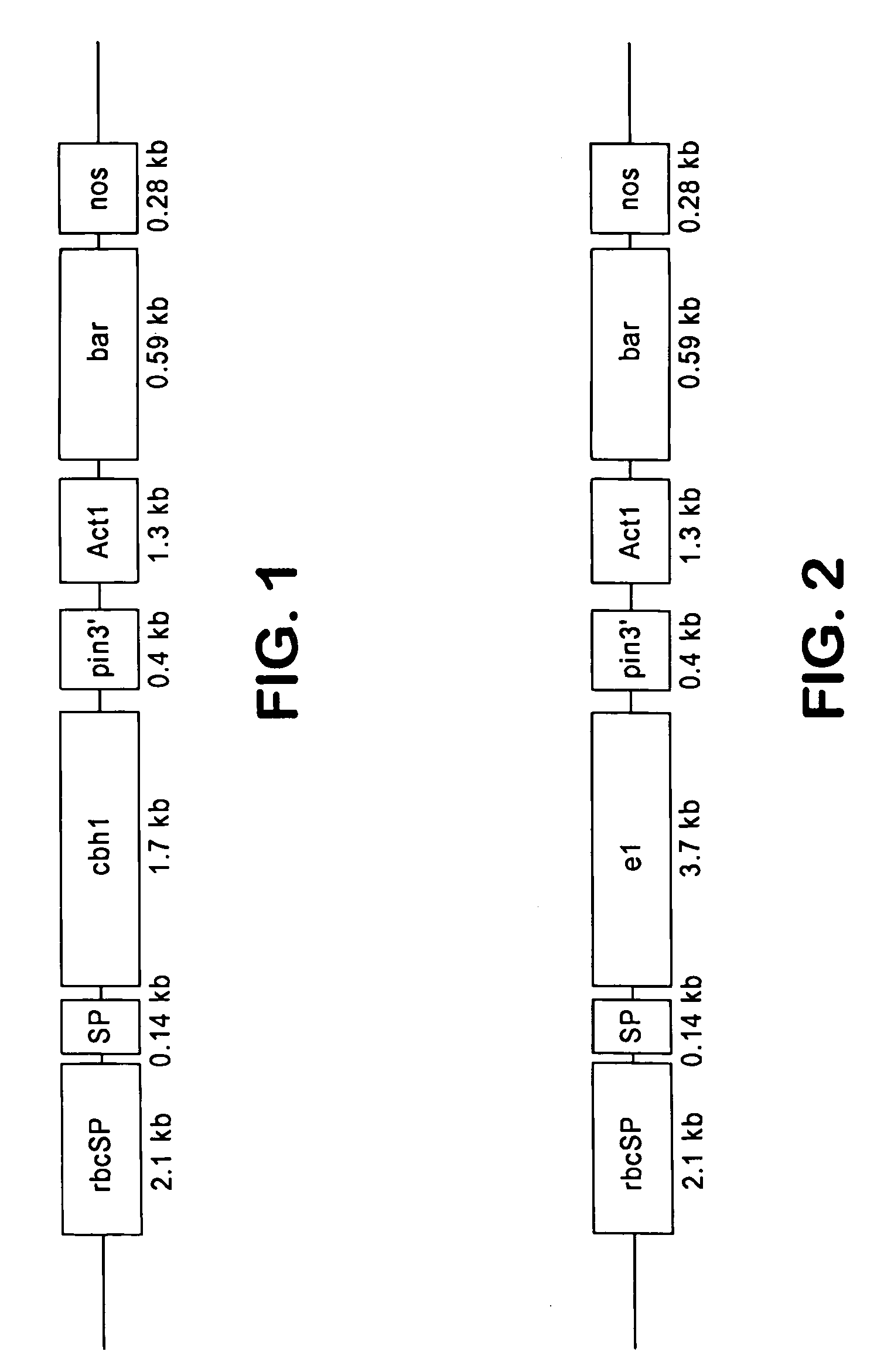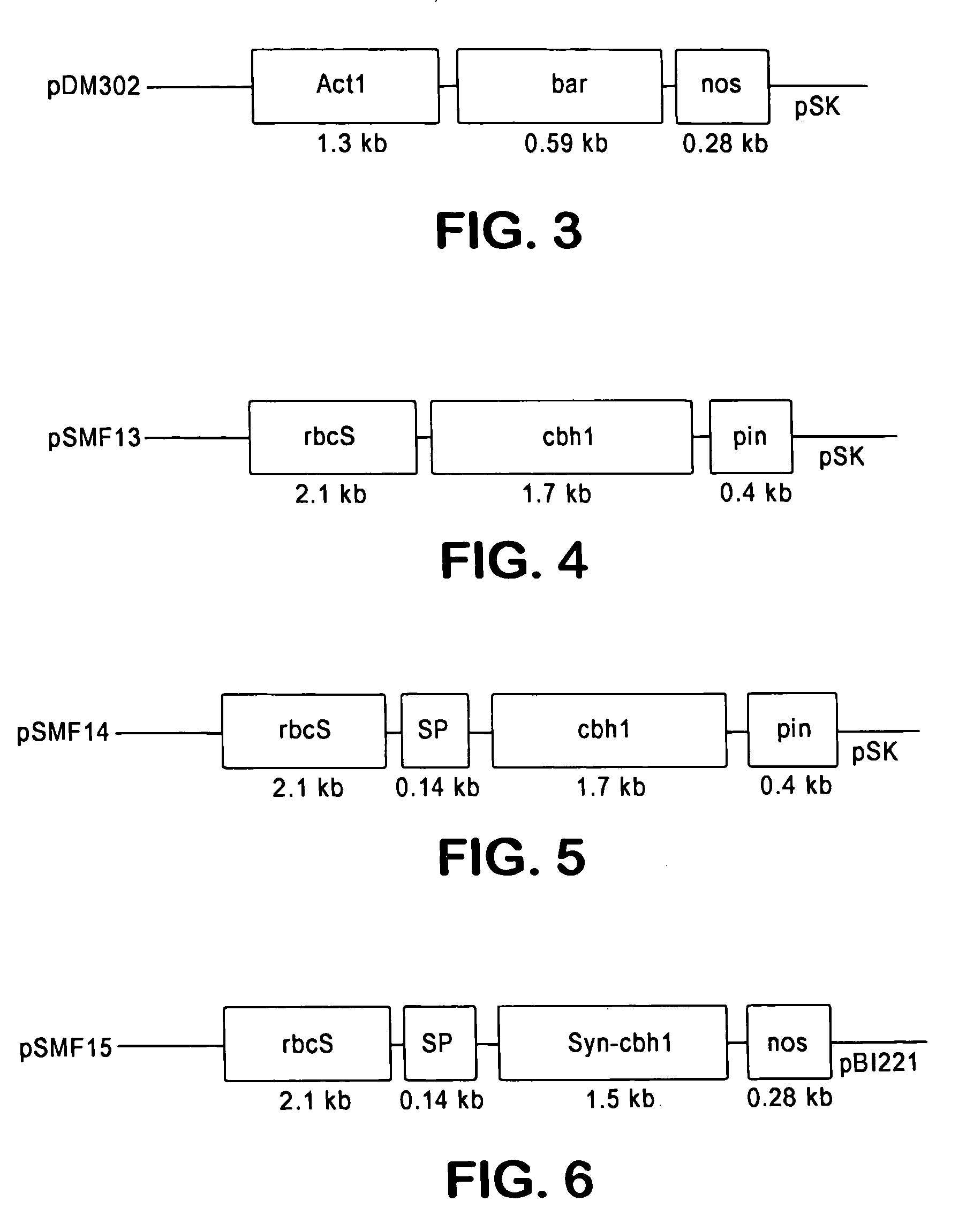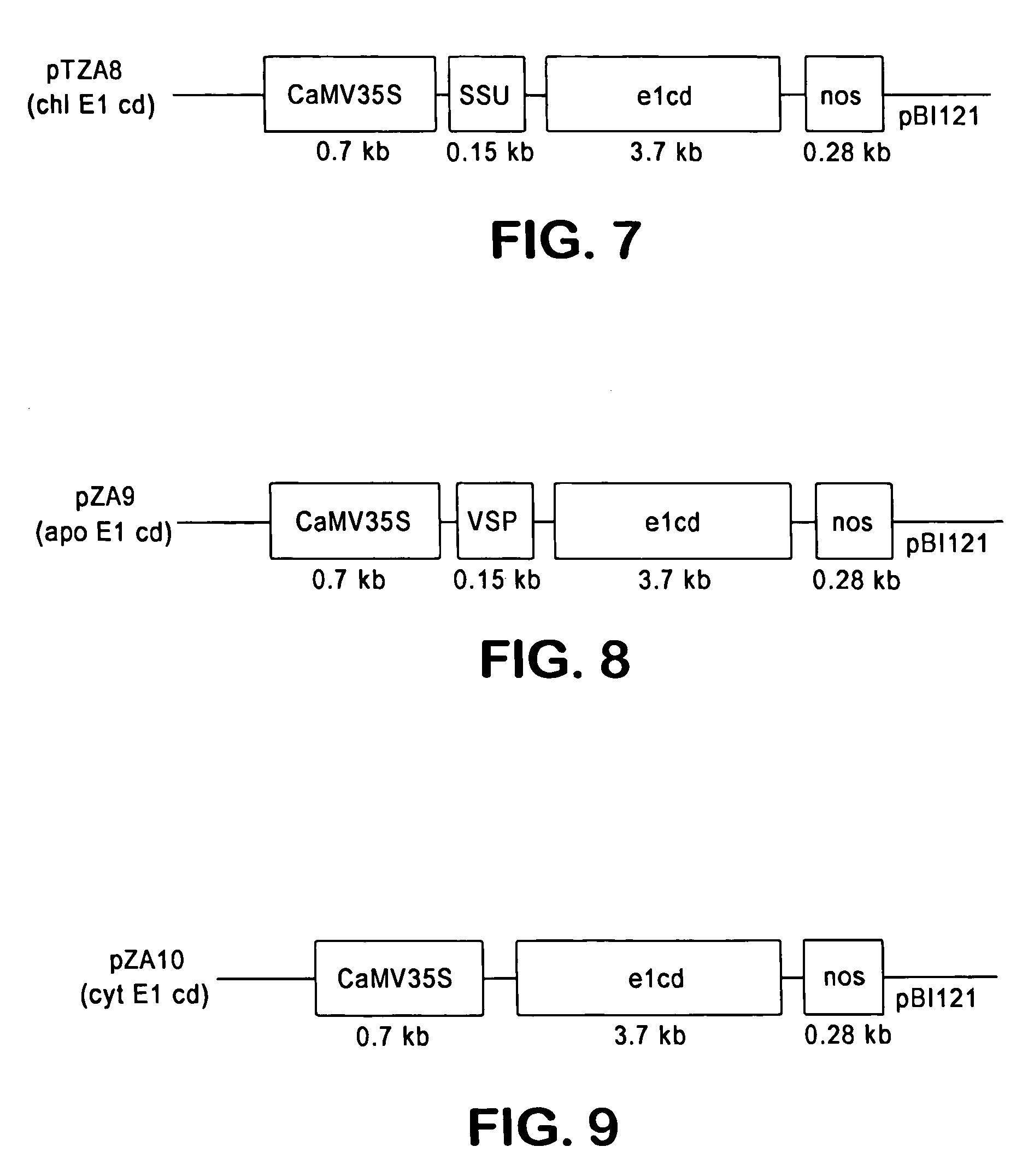Transgenic plants containing ligninase and cellulase which degrade lignin and cellulose to fermentable sugars
- Summary
- Abstract
- Description
- Claims
- Application Information
AI Technical Summary
Benefits of technology
Problems solved by technology
Method used
Image
Examples
example 1
[0112]This example shows the construction of plasmids comprising a heterologous gene expression cassette comprising a DNA encoding a cellulase fusion protein and a heterologous gene expression cassette comprising a DNA encoding the bar gene (Table 1).
[0113]
TABLE 1ConstructPlasmid features1rbcSP / e1 / pin 3′ / / rbcSP leaf-specific promoter drivingAct1 P / bar / nos 3′cellulase cDNA of A. cellulolyticus2rbcSP / cbh1 / pin 3′ / / rbcSP leaf-specific promoter drivingAct1 P / bar / nos 3′cellulase cDNA of T. reesi3rbcSP / rbcS SP / e1 / pin 3′ / / The rbcS SP targets cellulase of A.Act1 P / bar / nos 3′cellulolyticus into maize chloroplasts4rbcSP / rbcS SP / cbh1 / pin 3′ / / The rbcS SP targets cellulase of T.Act1 P / bar / nos 3′reesi into maize chloroplasts
Abbreviations:
[0114]The term “rbcSP” means the rice rubisco rbcS promoter region. The rbc SP is a leaf-specific promoter that limits transcription of rbcS to the leaves (Schaeffer and Sheen, Plant Cell 3: 997–1012 (1991)). The nucleotide sequence for the rbcS promoter region is...
example 2
[0138]This example shows the construction of plasmids comprising a heterologous gene expression cassette comprising a DNA encoding a cellulase fusion protein. The plasmid constructs are shown in Table 2.
[0139]
TABLE 2ConstructPlasmid features1rbcSP / cbh1 / pin 3′rbcSP leaf-specific promoter drivingcellulase cDNA of T. reesei2rbcSP / rbcS SP / cbh1 / pin 3′The rbcS SP targets cellulase of T.reesi into maize chloroplasts3rbcSP / rbcS SP / syn-cbh1 / pin 3′The rbcS SP targets modifiedcellulase of T. reesei into maizechloroplasts4CaMv35s / SSU / e1 / nos3′The SSU targets the cellulase of A.cellulolyticus into maize chloroplasts5CaMv35s / VSP / e1 / nos3′The VSP targets the cellulase of A.cellulolyticus into maize apoplasts6CaMv35s / e1 / nos3′No signal peptide
Abbreviations:
[0140]The term “syn-cbh1” refers to a cbh1 gene that has been codon-modified for use in transformation of tobacco plants. It is available from.
[0141]The term “CaMV35s” refers to the cauliflower mosaic virus promoter.
[0142]The term “SSU” refers to th...
example 3
[0160]This example shows the construction of plasmids comprising a heterologous gene expression cassette comprising a DNA encoding a ligninase fusion protein and a heterologous gene expression cassette comprising a DNA encoding the bar gene. The constructs are shown in Table 3.
[0161]
TABLE 3ConstructPlasmid features1rbcSP / ckg4 / pin 3′ / / rbcSP leaf-specific promoter drivingAct1 P / bar / nos 3′ckg4 cDNA of P. chrysosporium2rbcSP / ckg5 / pin 3′ / / rbcSP leaf-specific promoter drivingAct1 P / bar / nos 3′ckg5 cDNA of P. chrysosporium3rbcSP / rbcS SP / ckg4 / pin 3′ / / The rbcS SP targets ckg4 into maizeAct1 P / bar / nos 3′chloroplasts4rbcSP / rbcS SP / ckg5 / pin 3′ / / The rbcS SP targets ckg5 into maizeAct1 P / bar / nos 3′chloroplasts
Abbreviations:
[0162]The terms “ckg4” and “ckg5” mean the ligninase cDNAs isolated from the basidiomycete Phanerochaete. chrysosporium, SEQ ID NO:11 and SEQ ID NO:13, respectively. The codons for the 28 amino acid leader are deleted so that the expressed gene product remains inside the cells.
[...
PUM
| Property | Measurement | Unit |
|---|---|---|
| Electrical resistance | aaaaa | aaaaa |
Abstract
Description
Claims
Application Information
 Login to View More
Login to View More - R&D
- Intellectual Property
- Life Sciences
- Materials
- Tech Scout
- Unparalleled Data Quality
- Higher Quality Content
- 60% Fewer Hallucinations
Browse by: Latest US Patents, China's latest patents, Technical Efficacy Thesaurus, Application Domain, Technology Topic, Popular Technical Reports.
© 2025 PatSnap. All rights reserved.Legal|Privacy policy|Modern Slavery Act Transparency Statement|Sitemap|About US| Contact US: help@patsnap.com



